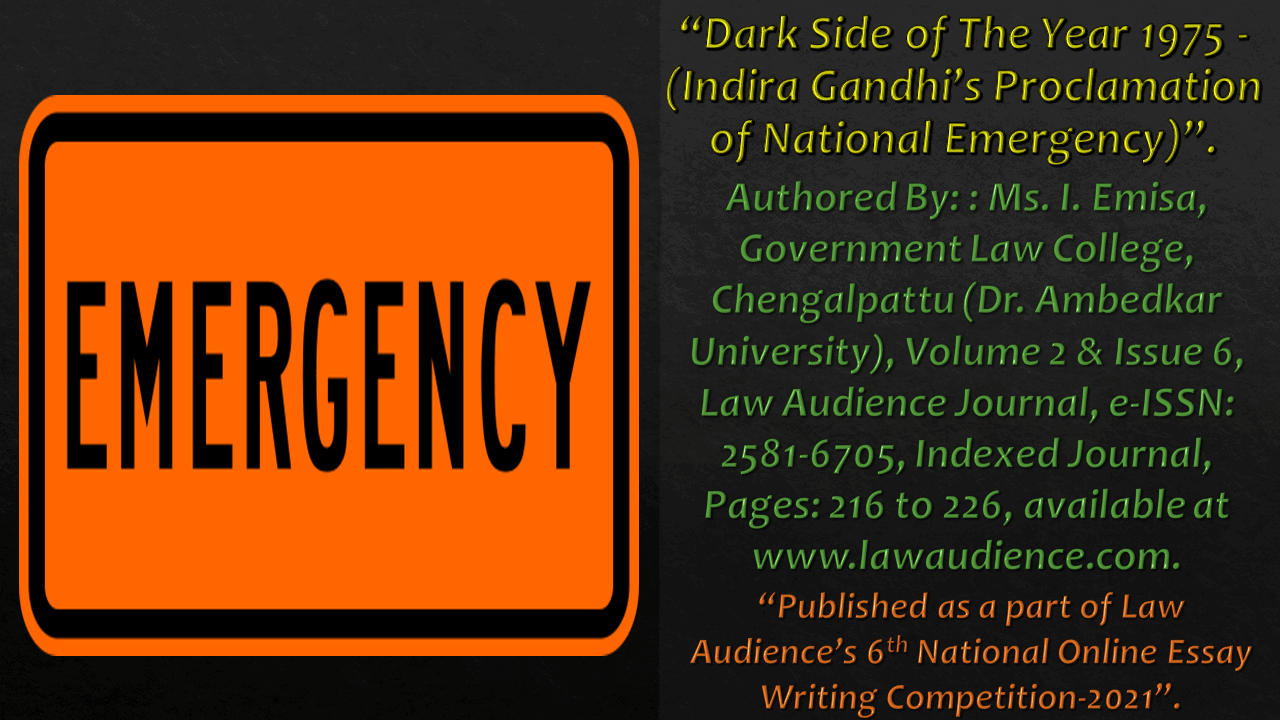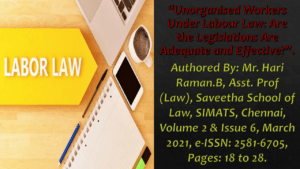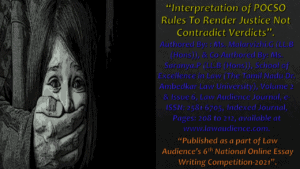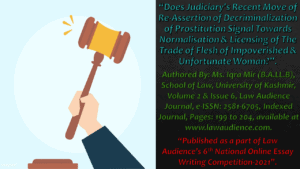Click here to download the full paper (PDF)
Authored By: Ms. I. Emisa (B.A.LL.B), Government Law College, Chengalpattu (Dr. Ambedkar University),
Click here for Copyright Policy.
I. INTRODUCTION:
“India is a federal country with Central Government and State Government. But at one period of time, India changes into a unitary form of Government. That is, the Central Government is vested with more power than the State Government at one particular period of time. At that particular period of time, the State Government can take executive actions or enact laws in the State but it cannot override the executive actions and enacted laws of Central Government on the same matter. This unitary form will appear during the period of Emergency. This was stated indirectly under Article 353 of the Indian Constitution. There were three types of Emergencies. They were National Emergency, State Emergency and Financial Emergency. They were stated under Articles 352 to 360 of the Constitution of India. This essay deals with the meaning of National Emergency along with the 1975 National Emergency, its background, events happened during the continuance of this emergency and its effect in India and in the Indian Constitution”.
II. NATIONAL EMERGENCY UNDER ARTICLE 352 OF THE INDIAN CONSTITUTION:
Article 352 of the Indian Constitution allows the President of India to proclaim an Emergency when he is satisfied that the security of India or any of its parts is threatened by war, external aggression or armed rebellion. The word ‘satisfaction’ should include the opinion of the Prime Minister and Cabinet Ministers. The proclamation of Emergency can be revoked unless a resolution is passed for the approval by both the houses of Parliament by 2\3 majority. If it gets approved, the emergency can operate for 6 months. For further extension of 6 months, the same process or resolution takes place. The proclamation of emergency ceases within 30 days if it was not approved by the House of People (Lok Sabha) when it was in dissolution and approved only by the Council of States (Rajya Sabha).
If approved by Lok Sabha within 30 days, the emergency can operate for 6 months. The same process is for the further extension of the emergency. The proclamation of Emergency can be revoked when a resolution was passed by 1/10 of the members of the house of the people in a special sitting that was held within 14 days from the date on which the notice to move a resolution for disapproving is given to the Speaker of Lok Sabha when the house is in session or to the President when the house is not in session. It can also be revoked by a subsequent proclamation by the President.
III. REASON BEHIND THE 1975 NATIONAL EMERGENCY:
III.I Navnirman movement:
At first, the protest by strike started by the students of LD College of Engineering in Ahmedabad against the sudden increase in college fees in December 1973. After one month the students of Gujarat University suddenly started to protest requesting for the removal of the then State Government. It was said as the movement for regeneration or nanvirman movement. The ruling party was Congress at that time. It was well known for its corrupt practices during that period. In a short period of time factory workers and other sector people joined in the protest.
Many of the public property get damaged in this protest. So, in February 1974, President’s rule was imposed on Gujarat and the assembly was suspended. Later, fresh election was announced in June 1974 because of the continuous agitation by Morarji Desai, an independent activist.
III.II JP Movement:
JP (Jayaprakash Narayan) was a freedom fighter. Seeing the protest of the students of Gujarat University, the students of Bihar were also protested against the Government in March 1974. This movement turned as a good chance for JP to rush Indira Gandhi and he called many of the students to boycott their schools and involve in the movement. Many opposite parties found it as helpful to defeat Indira Gandhi. So, they joined in the JP movement. In June 1974, JP called for a revolution against Congress Government. JP travelled along North India to convene people to stand against Indira Gandhi.
But Indira Gandhi denounced JP movement and challenged him to face her in the election and JP also accepted it and formed the National Coordination Committee. But after that the National Emergency was proclaimed.
III.III Railway Strike:
The Railway strike in Bihar was led by the Socialist leader George Fernandes. This strike leads to the stoppage of movement of goods and people during the month of May 1974. Many of the railway employees were arrested and the army was called out to maintain peace.
III.IV Verdict of Allahabad High Court:
In the case Indira Gandhi vs. Raj Narain[1], Indira Gandhi became the first Prime Minister to testify directly in court. Raj Narain, a socialist leader alleged that Indira Gandhi won the Parliamentary election in Rae Bareli, that held in 7 March 1971 through corrupt practices by spending more money for election than the allowed money which was mentioned under the Representation of People Act, 1951 and also alleged that the election campaign for her was carried out by some of the government officials and personally by her election agent Yashpal Kapoor and had used air force planes to file her nomination paper in Rae Bareli.[2]
The above allegations were proved against Indira Gandhi by the opposite counsel, Raj Narain’s Advocate, Shanti Bhushan. On 12 June 1975, Justice Jagamohan Lal Sinha read out the judgement in the Allahabad High Court declaring Gandhi’s election to Parliament as null and void.[3] So, Indira Gandhi appealed to the Supreme Court and on 24 June 1975 the Supreme Court put a conditional stay on the High Court order saying “Gandhi can attend Parliament meeting but not entitled to vote”. But Raj Narain dissatisfied with this judgement and appealed on this judgement. But after two days, on 26 June 1975, the National Emergency was proclaimed by the then President Fakhruddin Ali Ahmed on the ground of ‘internal disturbance’.
IV. PROCLAMATION OF 1975 NATIONAL EMERGENCY:
Already there was a National Emergency was in existence which was proclaimed in 1971 on the ground of ‘external aggression’. By the 38th Constitutional Amendment Act, 1975, the Constitution confers power on the President to proclaim emergency on different grounds stated under Article 352(1) whether or not there is a proclamation of emergency already in operation under Article 352(9).
So, in the dark midnight, on 26 June 1975, the then Prime Minister Indira Gandhi announced through All India Radio as “The President has declared a State of Emergency. There is no need of panic”.[4]
This proclamation of Emergency had been signed the previous night itself by the then President Fakhruddiin Ali Ahmed. It was not decided with the cabinet. The decision of emergency was only made by the recommendation of Prime Minister alone without discussing with cabinet ministers. The leaders like Jayaprakash Narayan, Morarji Desai, Atal Bihari Vajpayee, LK Advani, Asoka Mehta and many other leaders were imprisoned for the violation of rules during the emergency.
Indira Gandhi has said that this emergency is proclaimed to protect the national interest because, the security and democracy of India was in imminent danger, there was a need for rapid economic development and upliftment of the underprivileged and to prevent intervention of powers from outside which could lead to weaken India.[5]
The democracy of India was dead during this emergency because the six freedoms under Article 19 of the Indian Constitution were suspended under Article 358 and the enforcement of fundamental rights conferred by Article 14, 21 and 22 remain suspended by the Presidential order and the cases pending related to this provision also get suspended during this emergency. The Amendment power also got misused.
V. EVENTS THAT HAPPENED DURING THE 1975 NATIONAL EMERGENCY:
V.I Detaining People Without Saying Reason:
The Presidential Order issued under Article 359 on 27 June 1975, suspended the enforcement of Article 22 (protection against detention), Article 14 and Article 21 of the Indian Constitution. On 8 January 1976, the six freedoms of Article 19 also got suspended by a Presidential order under Article 358. Meanwhile, the Maintenance of Internal Security Act (MISA) gets amended and states that the grounds of detention were not to be communicated with detenu and it cannot be reviewed by advisory board which was envisaged under Article 22 of the Indian Constitution. In KM Ghatage vs. Union of India[6], the High Court held that the judicial review of preventive detention under MISA was possible when the scope of Article 358 is used ultravires or found to be malafide. But in ADM Jabalpur vs. S. Shukla[7], the Supreme Court overruled the High Court’s judgement on the above-mentioned case.
V.II Suspension of Article 19 of the Indian Constitution:
Article 19 of the Indian Constitution guarantees six freedoms to the Indian citizens. They were freedom of speech and expression, freedom to assemble peacefully without arms, freedom to form association, unions or co-operative societies, freedom to move freely throughout the territory of India, freedom to reside and settle in any part of the territory of India and freedom to practice any profession or to carry on any occupation, trade or business[8]. During the period of 1975 National Emergency, a presidential order was issued suspending the enforcement of freedoms guaranteed by Article 19 under Article 358 on 8 January 1976. The laws enacted or executive actions taken were not to be challenged in courts for its inconsistency to the freedoms under Article 19. This power was greatly misused during this emergency period and many people were detained for using these freedoms. It also misused Article 358 by saying that the ‘things done or omitted to be done’ cannot be challenged even after the emergency.
V.III Suspension of Other Fundamental Rights:
On 27 June 1975, a Presidential Order was issued under Article 359 suspending the right to approach courts for the enforcement of rights under Article 14, 21 and 22. These rights were greatly misused by the Government. For instance, in ADM Jabalpur vs. Shivkant Shukla[9], it was held by a majority of 4:1 that “no person will have any locus standi to move a petition to High Court under Article 226 to enforce any of the writs, to challenge the detention order on any ground”.[10] But Justice Khanna gave a dissenting judgement and argued that Article 21 is not a sole repository and it is a statutory right. So the violation of this can be challenged under Article 226 of the Constitution of India. But however, the court rejected this view and held by a majority that “Article 21 was the ‘sole repository’ of the right to life and personal liberty against the State.”[11]
So, a writ of habeas corpus to challenge detention will amount to enforce the right to personal liberty under Article 21 which was suspended by Presidential Order. It also held that Article 21 contains the words ‘procedure established by law’. So the person complaining his detention under MISA as unlawful is the violation of Article 21. This judgement was criticised by many scholars.
When the judgement of Makhan Singh vs. State of Punjab[12], is taken into consideration, which was decided in the period of 1962 National Emergency, it is said that “when the detention infringe the rights which were not stated under the Presidential order or when it is malafide, it can be challenged in courts. But the Supreme Court rejected this view and held that the Presidential Order in 1962 was conditional because it only related to persons who were detained in Defence of India Act. But 1975 Presidential Order was blanket order and not only relates to persons detained under a particular law.”[13]
V.IV 20 Point Programme:
On 1 July 1975 Indira Gandhi introduced a 20-point programme to develop economic growth. It includes land to homeless poor, review of laws on minimum agricultural wages, prevention of tax evasion, essential commodities at controlled prices etc.
But in the meantime, Indira Gandhi’s son Sanjay Gandhi showed his arrogant activities towards the people by forcibly taking the workers to him and imposed the scheme of family planning upon them. This made most of the people get angry against Indira Gandhi, her rule and in her 20-point programme. So, there were no developments achieved from this programme. People criticize the scheme as “problems are plenty, points are twenty, results are empty”.[14]
V.V End of 1975 National Emergency:
The National Emergency of 1971 and the National Emergency of 1975 was withdrawn at 21 March 1977 by the then Prime Minister Indira Gandhi. The main reason for the end of Emergency is because of Sanjay Gandhi’s omnipotence.
He thinks his word was law and whatever he wanted; he will get. This led the leaders to think of changing Parliamentary form of government into Presidential form.
So they planned to set up Constituent assembly in the Parliament. But soon a resolution was passed to set up a Constituent assembly by the State assemblies of Uttar Pradesh, Punjab and Haryana. So, to stop things from getting out of hand Indira Gandhi withdrew the emergency.
VI. EFFECTS OF 1975 NATIONAL EMERGENCY:
VI.I Defeat of Indira Gandhi in Parliamentary Election:
Indira Gandhi announced in All India Radio at 8pm on 18 January 1977, that the Lok Sabha had been dissolved and fresh election would be held in March.[15]
Polling held from 16 to 20 March 1977. But Indira Gandhi faced a severe defeat in the Parliamentary election and the opposition leader Morarji Desai of Janata party becomes the 5th Prime Minister of India on 24 March 1977.
VI.II 44th Constitutional Amendment Act, 1978:
- Before 1978, the grounds for emergency were war, external aggression or internal disturbance. By the 44th Constitutional Amendment Act the word ‘internal disturbance’ was taken away and the word ‘armed rebellion’ was inserted in that place because the ground internal disturbance is too vague.
- This 44th Constitutional Amendment Act inserted a new clause Article 352 clause (3) stating that the President shall not issue a proclamation of emergency unless the Prime Minister and the Cabinet Ministers make a decision on this issue and communicated to him in writing.
- Before 1978, the time for approval of the proclamation of emergency by both the house of Parliament is two months. But 44th Amendment Act reduced it to one month.
- Before 1978, the resolution for the approval of emergency can be passed by simple majority in each house was sufficient. But 44th Amendment Act made it to pass with not less than 2/3 majority of the members present in each house.
- Before 1978, once the Parliament approves for the emergency, it will remain in force till the desire of the executive to withdraw. But after the 44th Amendment Act the life of emergency is for six months. For further extension it should be approved by Parliament and passed with 2/3 majority.
- The 44th Amendment Act inserted Article 352 clause (8) which states that the emergency can be revoked if it was disapproved by members with simple majority. It also introduced Article 352 clause (8) which provides that where a notice in writing was signed by not less than 1/10th of the total members of the Lok Sabha and showed their intention to move a resolution for disapproving the proclamation of emergency, then within 14 days the Speaker, if the house is in session or the President, if the house is not in session should pass the resolution for disapproving it with simple majority.
- This amendment made Article 352(5) to remain in the same position as it was like before the 1975 emergency. That is, the ‘satisfaction’ of the President is subjected to judicial review.
- The 44th Amendment Act also inserted under Article 359 that, Article 20 and 21 of the Indian Constitution cannot be suspended even during the emergency.
These were the changes made in the emergency provisions by the 44th Amendment Act. This Amendment prevented the misuse of emergency provisions after the 1975 National Emergency.
VII. CONCLUSION:
One of the most important powers vested with the Indian President from the Constitution of India is the Emergency power. This power was inserted in the Constitution (Article 352-360) to protect the security of India and its parts. So, it cannot be misused by the President or by the Prime Minister.
India had faced three National Emergencies during the years 1962 (Indo-China Emergency, 1971(Indo-Pakistan Emergency) and 1975 Internal National Emergency. But among these three emergencies 1975 National Emergency was issued for the personal crisis of Indira Gandhi. Though there were some economic improvements, the rights of people were completely destroyed during the period of this emergency. So, one side of this proclamation of emergency was considered as the dark side of the year 1975. But after the 44th Constitutional Amendment Act, 1978 the misuse of the emergency provision gets completely reduced because of the stringent restriction made in the provisions.
We can proudly say that after the 44th Amendment Act there was no proclamation of National Emergency till now (as per 2021) in the Independent India. We should remember one thing, that “National Emergency should be used for the protection of the right of the citizens and not as the power over the rights of the citizens.”
Footnotes:
[1] Indira Gandhi v. Raj Narain, 1975 A.I.R. 1975 S.C. 2299 (India).
[2] PRASHANT BHUSHAN, THE CASE THAT SHOOK INDIA 4-5, 7-8 (New ed., Penguin books, 2018).
[3] Adrija Roychowdhury, Four reasons why Indira Gandhi declared Emergency, THE INDIAN EXPRESS (Jan. 25, 2018, 12:37:28 PM), https://indianexpress-com.cdn.ampproject.org/v/s/indianexpress.com/article/research/four-reasons-why-indira-gandhi-declared-the-emergency-523239/lite/?amp_js_v_a6&_gsa=1&usqp=mq331AQHKAFQArAAABIA%3D%3D#aoh=16204553213270&referer=https%3A%2F%2Fwww.google.com&_tf=from%20%251%245&share=https%3A%2F%2Findianexpress.com%2Farticle%2Fresearch%2Ffour-reasons-why-indira-gandhi-declared-the-emergency-5232397%2F.
[4] Prabhash K Dutta, 44th anniversary: When Indira Gandhi declared Emergency after these setbacks, INDIA TODAY (June 25, 2019, 10:09 IST) https://www.indiatoday.in/india/story/indira-gandhi-emergency-june-25-26-1975-after-5-setbacks-1269294-2018-06-25?amp_js_v=a6&_gsa=1&usqp=mq331AQHKAFWArABIA%3D%3D#aih=16204570266698&_ct=162004579931318referrer=https%3A%2F%2Fwww.ggogle.com&_tf=From%20%251%245&share=https%3A%2F%2Fwww.indiatoday.in%2Findia%2Fstory%2Findira-gandhi-emergency-june-25-26-1975-after-5-setbacks-1369294-2018-06-25.
[5] Ibid.
[6] K M Ghatage v. Union of India, A.I.R. 1975 Bom. 324 (India).
[7] ADM Jabalpur v. S. Shukla, A.I.R. 1976 S.C. 1207 (India).
[8] Dr. J. N. PANDEY, CONSTITUTIONAL LAW OF INDIA 208-209 (56th ed., Central Law Agency, 2019).
[9] Ibid.
[10] M.P. JAIN, INDIAN CONSTITUTIONAL LAW 1450-1451 (8th ed. Lexis Nexis, Saurabh Printers Pvt. Ltd., 2018).
[11] Id., at 1451.
[12] Makhan Singh v. State of Punjab, A.I.R. 1964 S.C. 381 (India).
[13] Dr. J.N. PANDEY, CONSTITUTIONAL LAW OF INDIA 818-819 (56th ed., Central Law Agency 2019).
[14] 1975 Emergency Under Indira Gandhi, NEWS7 TAMIL, https://youtu.be/Tlx5Ufl3pbk.
[15] Inder Malhotra, The abrupt end of Emergency, THE INDIAN EXPRESS, (Aug. 4, 2014, 12:42:34 AM) https://indianexpress-com.cdn.ampproject.org/v/s/indianexpress.com/article/opinion/columns/the-abrupt-end-of-emergency/lite/amp_js_v-a6&_gsa=1&usqp=mq331AQHKAFQArABIA%3D%3D#aoh=16204570266698&_ct=1620457041352&referrer=https%3A%2F%2Fwww.google.com&_tf=From%20%25%24s&share=https%3A%2F%2Findianexpress.com%2Farticle%2Fopinion%2Fcolumns%2Fthe-abrupt-end-of-emergency%2F.
Bibliography:
I. Books Referred:
- J.N. Pandey, Constitutional Law of India, 56th edition, Central Law Agency, 2019.
- P. Jain, Indian Constitutional Law, 8th edition, Lexis Nexis, 2018.
- Prashant Bhushan, the case that shook India, new edition, penguin books, 2018.
II. Cases referred:
- Indira Gandhi v. Raj Narain.
- K M Ghatage v. Union of India.
- ADM Jabalpur v. Shivkant Shukla.
- Makhan Singh v. State of Punjab.
III. Websites visited:
- indianexpress.com.
- indiatoday.com.
- YouTube:
- https://youtu.be/Tlx5Ufl3pbk.
Cite this article as:
Ms. I. Emisa, Dark Side of The Year 1975 – (Indira Gandhi’s Proclamation of National Emergency), Vol.2 & Issue 6, Law Audience Journal, Pages 216 to 226 (29th June 2021), available at https://www.lawaudience.com/dark-side-of-the-year-1975-indira-gandhis-proclamation-of-national-emergency/.



